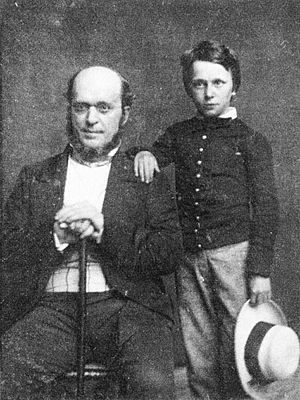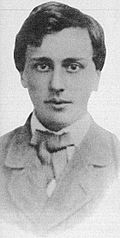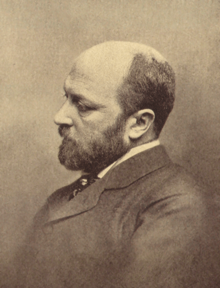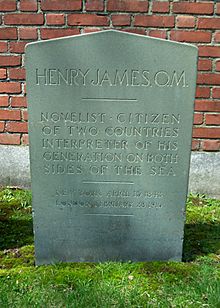Henry James facts for kids
Quick facts for kids
Henry James
|
|
|---|---|
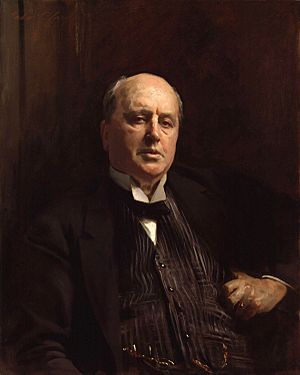
James in 1913
|
|
| Born | 15 April 1843 New York City, U.S. |
| Died | 28 February 1916 (aged 72) Chelsea, London, England |
| Occupation | Writer |
| Citizenship | American (1843–1915) British (1915–1916) |
| Alma mater | Harvard Law School |
| Period | 1863–1916 |
| Notable works | The American (1877) Daisy Miller (1879) Washington Square (1880) The Portrait of a Lady (1881) The Bostonians (1886) The Aspern Papers (1888) What Maisie Knew (1897) The Turn of the Screw (1898) The Wings of the Dove (1902) The Ambassadors (1903) The Golden Bowl (1904) |
| Relatives | Henry James Sr. (father) William James (brother) Alice James (sister) |
|
|
|
| Signature |  |
Henry James OM (15 April 1843 – 28 February 1916 ) was an American-British author. He is regarded as a key transitional figure between literary realism and literary modernism, and is considered by many to be among the greatest novelists in the English language. He was the son of Henry James Sr. and the brother of philosopher and psychologist William James and diarist Alice James.
He is best known for his novels dealing with the social and marital interplay between émigré Americans, English people, and continental Europeans. Examples of such novels include The Portrait of a Lady, The Ambassadors, and The Wings of the Dove. His later works were increasingly experimental. In describing the internal states of mind and social dynamics of his characters, James often wrote in a style in which ambiguous or contradictory motives and impressions were overlaid or juxtaposed in the discussion of a character's psyche. For their unique ambiguity, as well as for other aspects of their composition, his late works have been compared to impressionist painting.
His novella The Turn of the Screw has garnered a reputation as the most analysed and ambiguous ghost story in the English language and remains his most widely adapted work in other media. He also wrote other highly regarded ghost stories.
James published articles and books of criticism, travel, biography, autobiography, and plays. Born in the United States, James largely relocated to Europe as a young man, and eventually settled in England, becoming a British citizen in 1915, a year before his death. James was nominated for the Nobel Prize in Literature in 1911, 1912, and 1916.
Contents
Life
Early years, 1843–1883
James was born at 21 Washington Place in New York City on 15 April 1843. His parents were Mary Walsh and Henry James Sr. His father was intelligent and steadfastly congenial. He was a lecturer and philosopher who had inherited independent means from his father, an Albany banker and investor. Mary came from a wealthy family long settled in New York City. Her sister Katherine lived with her adult family for an extended period of time. Henry Jr. was one of four boys, the others being William, who was one year his senior, and younger brothers Wilkinson (Wilkie) and Robertson. His younger sister was Alice. Both of his parents were of Irish and Scottish descent.
Before he was a year old, his father sold the house at Washington Place and took the family to Europe, where they lived for a time in a cottage in Windsor Great Park in England. The family returned to New York in 1845, and Henry spent much of his childhood living between his paternal grandmother's home in Albany, and a house on 14th Street in Manhattan. His education was calculated by his father to expose him to many influences, primarily scientific and philosophical; it was described by Percy Lubbock, the editor of his selected letters, as "extraordinarily haphazard." James did not share the usual education in Latin and Greek classics. Between 1855 and 1860, the James household travelled to London, Paris, Geneva, Boulogne-sur-Mer, and Newport, Rhode Island, according to the father's current interests and publishing ventures, retreating to the United States when funds were low. Henry studied primarily with tutors, and briefly attended schools while the family travelled in Europe. Their longest stays were in France, where Henry began to feel at home and became fluent in French. He had a stutter, which seems to have manifested itself only when he spoke English; in French, he did not stutter.
In 1860, the family returned to Newport. There, Henry became a friend of painter John La Farge, who introduced him to French literature, and in particular, to Balzac. James later called Balzac his "greatest master", and said that he had learned more about the craft of fiction from him than from anyone else.
In the autumn of 1861, James received an injury, probably to his back, while fighting a fire. This injury, which resurfaced at times throughout his life, made him unfit for military service in the American Civil War.
In 1864, the James family moved to Boston, Massachusetts, to be near William, who had enrolled first in the Lawrence Scientific School at Harvard and then in the medical school. In 1862, Henry attended Harvard Law School, but realised that he was not interested in studying law. He pursued his interest in literature and associated with authors and critics William Dean Howells and Charles Eliot Norton in Boston and Cambridge and formed lifelong friendships with Oliver Wendell Holmes Jr., the future Supreme Court justice, and with James T. Fields and Annie Adams Fields, his first professional mentors.
His first published work was a review of a stage performance, "Miss Maggie Mitchell in Fanchon the Cricket", published in 1863. About a year later, "A Tragedy of Error", his first short story, was published anonymously. James's first literary payment was for an appreciation of Sir Walter Scott's novels, written for the North American Review. He wrote fiction and nonfiction pieces for The Nation and Atlantic Monthly, where Fields was editor. In 1871, he published his first novel, Watch and Ward, in serial form in the Atlantic Monthly. The novel was later published in book form in 1878.
During a 14-month trip through Europe in 1869–70, he met John Ruskin, Charles Dickens, Matthew Arnold, William Morris, and George Eliot. Rome impressed him profoundly. "Here I am then in the Eternal City", he wrote to his brother William. "At last—for the first time—I live!" He attempted to support himself as a freelance writer in Rome and then secured a position as Paris correspondent for the New York Tribune through the influence of its editor, John Hay. When these efforts failed, he returned to New York City. During 1874 and 1875, he published Transatlantic Sketches, A Passionate Pilgrim and Roderick Hudson. During this early period in his career, he was influenced by Nathaniel Hawthorne.
In 1875, he headed for Paris, and by 1876, he settled in London, where he established relationships with Macmillan and other publishers, who paid for serial installments that they published in book form. The audience for these serialized novels was largely made up of middle-class women, and James struggled to fashion serious literary work within the strictures imposed by editors' and publishers' notions of what was suitable for young women to read. He lived in rented rooms, but was able to join gentlemen's clubs that had libraries and where he could entertain male friends. He was introduced to English society by Henry Adams and Charles Milnes Gaskell, the latter introducing him to the Travellers' and the Reform Clubs. He was also an honorary member of the Savile Club, St James's Club and, in 1882, the Athenaeum Club.
In the fall of 1875, he moved to the Latin Quarter of Paris. Aside from two trips to America, he spent the next three decades—the rest of his life—in Europe. In Paris, he met Zola, Daudet, Maupassant, Turgenev and others. He stayed in Paris only a year before moving to London.
In England, he met the leading figures of politics and culture. He continued to be a prolific writer, producing The American (1877), The Europeans (1878), a revision of Watch and Ward (1878), French Poets and Novelists (1878), Hawthorne (1879), and several shorter works of fiction. In 1878, Daisy Miller established his fame on both sides of the Atlantic. It drew notice perhaps mostly because it depicted a woman whose behavior is outside the social norms of Europe. He also began his first masterpiece, The Portrait of a Lady, which appeared in 1881.
In 1877, he first visited Wenlock Abbey in Shropshire, home of his friend Charles Milnes Gaskell, whom he had met through Henry Adams. He was much inspired by the darkly romantic abbey and the surrounding countryside, which feature in his essay "Abbeys and Castles". In particular, the gloomy monastic fishponds behind the abbey are said to have inspired the lake in The Turn of the Screw.
While living in London, James continued to follow the careers of the French realists, Émile Zola in particular. Their stylistic methods influenced his own work in the years to come. Hawthorne's influence on him faded during this period, replaced by George Eliot and Ivan Turgenev. The period from 1878 to 1881 had the publication of The Europeans, Washington Square, Confidence and The Portrait of a Lady.
The period from 1882 to 1883 was marked by several losses. His mother died in January 1882, while James was in Washington, D.C., on an extended visit to America. He returned to his parents' home in Cambridge, where he was together with all four of his siblings for the first time in 15 years. He returned to Europe in mid-1882, but was back in America by the end of the year following the death of his father. Emerson, an old family friend, died in 1882. His brother Wilkie and friend Turgenev both died in 1883.
Middle years, 1884–1897
In 1884, James made another visit to Paris, where he met again with Zola, Daudet, and Goncourt. He had been following the careers of the French "realist" or "naturalist" writers, and was increasingly influenced by them. In 1886, he published The Bostonians and The Princess Casamassima, both influenced by the French writers that he had studied assiduously. Critical reaction and sales were poor. He wrote to Howells that the books had hurt his career rather than helped because they had "reduced the desire, and demand, for my productions to zero.” During this time, he became friends with Robert Louis Stevenson, John Singer Sargent, Edmund Gosse, George du Maurier, Paul Bourget, and Constance Fenimore Woolson. His third novel from the 1880s was The Tragic Muse. Although he was following the precepts of Zola in his novels of the '80s, their tone and attitude are closer to the fiction of Alphonse Daudet. The lack of critical and financial success for his novels during this period led him to try writing for the theatre; His dramatic works and his experiences with theatre are discussed below.
In the last quarter of 1889, "for pure and copious lucre," he started translating Port Tarascon, the third volume of Daudet's adventures of Tartarin de Tarascon. Serialized in Harper's Monthly from June 1890, this translation – praised as "clever" by The Spectator – was published in January 1891 by Sampson Low, Marston, Searle & Rivington.
After the stage failure of Guy Domville in 1895, James was near despair and thoughts of death plagued him. His depression was compounded by the deaths of those closest to him, including his sister Alice in 1892; his friend Wolcott Balestier in 1891; and Stevenson and Fenimore Woolson in 1894. The sudden death of Fenimore Woolson in January 1894 was particularly painful for him. Leon Edel wrote that the reverberations from Fenimore Woolson's death were such that "we can read a strong element of guilt and bewilderment in his letters, and, even more, in those extraordinary tales of the next half-dozen years, "The Altar of the Dead" and "The Beast in the Jungle".
The years spent on dramatic works were not entirely a loss. As he moved into the last phase of his career, he found ways to adapt dramatic techniques into the novel form. In the late 1880s and throughout the 1890s, James made several trips through Europe. He spent a long stay in Italy in 1887. In that year, he published the short novel The Aspern Papers and The Reverberator.
Late years, 1898–1916
In 1897–1898, he moved to Rye, Sussex and wrote The Turn of the Screw; 1899–1900 had the publication of The Awkward Age and The Sacred Fount. During 1902–1904, he wrote The Wings of the Dove, The Ambassadors, and The Golden Bowl.
In 1904, he revisited America and lectured on Balzac. In 1906–1910, he published The American Scene and edited the "New York Edition", a 24-volume collection of his works. In 1910, his brother William died; Henry had just joined William from an unsuccessful search for relief in Europe, on what turned out to be Henry's last visit to the United States (summer 1910 to July 1911) and was near him when he died.
In 1913, he wrote his autobiographies, A Small Boy and Others, and Notes of a Son and Brother. After the outbreak of the First World War in 1914, he did war work. In 1915, he became a British citizen and was awarded the Order of Merit the following year. He died on 28 February 1916, in Chelsea, London, and was cremated at Golders Green Crematorium. As he requested, his ashes were buried in Cambridge Cemetery in Massachusetts.
Works
Style and themes
James is one of the major figures of trans-Atlantic literature. His works frequently juxtapose characters from the Old World (Europe), embodying a feudal civilisation that is beautiful, often corrupt, and alluring, and from the New World (United States), where people are often brash, open, and assertive, and embody the virtues of the new American society — particularly personal freedom and a more exacting moral character. James explores this clash of personalities and cultures, in stories of personal relationships in which power is exercised well or badly.
His protagonists were often young American women facing oppression or abuse, and as his secretary Theodora Bosanquet remarked in her monograph Henry James at Work:
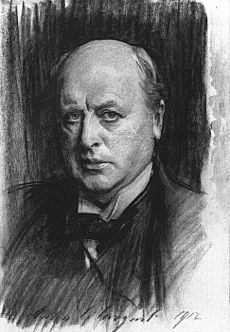
Philip Guedalla jokingly described three phases in the development of James's prose: "James I, James II, and The Old Pretender," and observers do often group his works of fiction into three periods. In his apprentice years, culminating with the masterwork The Portrait of a Lady, his style was simple and direct (by the standards of Victorian magazine writing) and he experimented widely with forms and methods, generally narrating from a conventionally omniscient point of view. Plots generally concern romance, except for the three big novels of social commentary that conclude this period. In the second period, as noted above, he abandoned the serialized novel and from 1890 to about 1897, he wrote short stories and plays. Finally, in his third and last period he returned to the long, serialised novel. Beginning in the second period, but most noticeably in the third, he increasingly abandoned direct statement in favour of frequent double negatives, and complex descriptive imagery. Single paragraphs began to run for page after page, in which an initial noun would be succeeded by pronouns surrounded by clouds of adjectives and prepositional clauses, far from their original referents, and verbs would be deferred and then preceded by a series of adverbs. The overall effect could be a vivid evocation of a scene as perceived by a sensitive observer. It has been debated whether this change of style was engendered by James's shifting from writing to dictating to a typist, a change made during the composition of What Maisie Knew.
In its intense focus on the consciousness of his major characters, James's later work foreshadows extensive developments in 20th-century fiction. Indeed, he might have influenced stream-of-consciousness writers such as Virginia Woolf, who not only read some of his novels but also wrote essays about them. Both contemporary and modern readers have found the late style difficult and unnecessary; his friend Edith Wharton, who admired him greatly, said that some passages in his work were all but incomprehensible. James was harshly portrayed by H. G. Wells as a hippopotamus laboriously attempting to pick up a pea that had got into a corner of its cage. The "late James" style was ably parodied by Max Beerbohm in "The Mote in the Middle Distance".
More important for his work overall may have been his position as an expatriate, and in other ways an outsider, living in Europe. While he came from middle-class and provincial beginnings (seen from the perspective of European polite society), he worked very hard to gain access to all levels of society, and the settings of his fiction range from working-class to aristocratic, and often describe the efforts of middle-class Americans to make their way in European capitals. He confessed he got some of his best story ideas from gossip at the dinner table or at country house weekends. He worked for a living, however, and lacked the experiences of select schools, university, and army service, the common bonds of masculine society. He was furthermore a man whose tastes and interests were, according to the prevailing standards of Victorian era Anglo-American culture, rather feminine, and who was shadowed by the cloud of prejudice that then and later accompanied suspicions of his homosexuality.
Many of James's stories may also be seen as psychological thought experiments about selection. In his preface to the New York edition of The American, James describes the development of the story in his mind as exactly such: the "situation" of an American, "some robust but insidiously beguiled and betrayed, some cruelly wronged, compatriot..." with the focus of the story being on the response of this wronged man. The Portrait of a Lady may be an experiment to see what happens when an idealistic young woman suddenly becomes very rich. In many of his tales, characters seem to exemplify alternative futures and possibilities, as most markedly in "The Jolly Corner", in which the protagonist and a ghost-doppelganger live alternative American and European lives; and in others, like The Ambassadors, an older James seems fondly to regard his own younger self facing a crucial moment.
Major novels
The first period of James's fiction, usually considered to have culminated in The Portrait of a Lady, concentrated on the contrast between Europe and America. The style of these novels is generally straightforward and, though personally characteristic, well within the norms of 19th-century fiction. Roderick Hudson (1875) is a Künstlerroman that traces the development of the title character, an extremely talented sculptor. Although the book shows some signs of immaturity—this was James's first serious attempt at a full-length novel—it has attracted favourable comment due to the vivid realisation of the three major characters: Roderick Hudson, superbly gifted but unstable and unreliable; Rowland Mallet, Roderick's limited but much more mature friend and patron; and Christina Light, one of James's most enchanting and maddening femmes fatales. The pair of Hudson and Mallet has been seen as representing the two sides of James's own nature: the wildly imaginative artist and the brooding conscientious mentor.
In The Portrait of a Lady (1881), James concluded the first phase of his career with a novel that remains his most popular piece of long fiction. The story is of a spirited young American woman, Isabel Archer, who "affronts her destiny" and finds it overwhelming. She inherits a large amount of money and subsequently becomes the victim of Machiavellian scheming by two American expatriates. The narrative is set mainly in Europe, especially in England and Italy. Generally regarded as the masterpiece of his early phase, The Portrait of a Lady is described as a psychological novel, exploring the minds of his characters, and almost a work of social science, exploring the differences between Europeans and Americans, the old and the new worlds.
The second period of James's career, which extends from the publication of The Portrait of a Lady through the end of the 19th century, features less popular novels, including The Princess Casamassima, published serially in The Atlantic Monthly in 1885–1886, and The Bostonians, published serially in The Century during the same period. This period also featured James's celebrated Gothic novella, The Turn of the Screw (1898).
The third period of James's career reached its most significant achievement in three novels published just around the start of the 20th century: The Wings of the Dove (1902), The Ambassadors (1903), and The Golden Bowl (1904). Critic F. O. Matthiessen called this "trilogy" James's major phase, and these novels have certainly received intense critical study. The second-written of the books, The Wings of the Dove, was the first published because it was not serialized. This novel tells the story of Milly Theale, an American heiress stricken with a serious disease, and her impact on the people around her. Some of these people befriend Milly with honourable motives, while others are more self-interested. James stated in his autobiographical books that Milly was based on Minny Temple, his beloved cousin, who died at an early age of tuberculosis. He said that he attempted in the novel to wrap her memory in the "beauty and dignity of art".
Shorter narratives
James was particularly interested in what he called the "beautiful and blest nouvelle", or the longer form of short narrative. Still, he produced a number of very short stories in which he achieved notable compression of sometimes complex subjects. The following narratives are representative of James's achievement in the shorter forms of fiction.
- "A Tragedy of Error" (1864), short story
- "The Story of a Year" (1865), short story
- A Passionate Pilgrim (1871), novella
- Madame de Mauves (1874), novella
- Daisy Miller (1878), novella
- The Aspern Papers (1888), novella
- The Lesson of the Master (1888), novella
- The Pupil (1891), short story
- "The Figure in the Carpet" (1896), short story
- The Beast in the Jungle (1903), novella
- An International Episode (1878)
- Picture and Text
- Four Meetings (1885)
- A London Life, and Other Tales (1889)
- The Spoils of Poynton (1896)
- Embarrassments (1896)
- The Two Magics: The Turn of the Screw, Covering End (1898)
- In the Cage (1898), novella
- A Little Tour of France (1900)
- The Sacred Fount (1901)
- The Birthplace (1903)
- Views and Reviews (1908)
- The Finer Grain (1910)
- The Outcry (1911)
- Lady Barbarina: The Siege of London, An International Episode and Other Tales (1922)
Plays
At several points in his career, James wrote plays, beginning with one-act plays written for periodicals in 1869 and 1871 and a dramatisation of his popular novella Daisy Miller in 1882. From 1890 to 1892, having received a bequest that freed him from magazine publication, he made a strenuous effort to succeed on the London stage, writing a half-dozen plays, of which only one, a dramatisation of his novel The American, was produced. This play was performed for several years by a touring repertory company, and had a respectable run in London, but did not earn very much money for James. His other plays written at this time were not produced.
In 1893, however, he responded to a request from actor-manager George Alexander for a serious play for the opening of his renovated St. James's Theatre, and wrote a long drama, Guy Domville, which Alexander produced. A noisy uproar arose on the opening night, 5 January 1895, with hissing from the gallery when James took his bow after the final curtain, and the author was upset. The play received moderately good reviews and had a modest run of four weeks before being taken off to make way for Oscar Wilde's The Importance of Being Earnest, which Alexander thought would have better prospects for the coming season.
After the stresses and disappointment of these efforts, James insisted that he would write no more for the theatre, but within weeks had agreed to write a curtain-raiser for Ellen Terry. This became the one-act "Summersoft", which he later rewrote into a short story, "Covering End", and then expanded into a full-length play, The High Bid, which had a brief run in London in 1907, when James made another concerted effort to write for the stage. He wrote three new plays, two of which were in production when the death of Edward VII on 6 May 1910 plunged London into mourning and theatres closed. Discouraged by failing health and the stresses of theatrical work, James did not renew his efforts in the theatre, but recycled his plays as successful novels. The Outcry was a best-seller in the United States when it was published in 1911. During 1890–1893, when he was most engaged with the theatre, James wrote a good deal of theatrical criticism, and assisted Elizabeth Robins and others in translating and producing Henrik Ibsen for the first time in London.
Leon Edel argued in his psychoanalytic biography that James was traumatised by the opening-night uproar that greeted Guy Domville, and that it plunged him into a prolonged depression. The successful later novels, in Edel's view, were the result of a kind of self-analysis, expressed in fiction, which partly freed him from his fears. Other biographers and scholars have not accepted this account, with the more common view being that of F.O. Matthiessen, who wrote: "Instead of being crushed by the collapse of his hopes [for the theatre]... he felt a resurgence of new energy."
Nonfiction
Beyond his fiction, James was one of the more important literary critics in the history of the novel. In his classic essay The Art of Fiction (1884), he argued against rigid prescriptions on the novelist's choice of subject and method of treatment. He maintained that the widest possible freedom in content and approach would help ensure narrative fiction's continued vitality. James wrote many critical articles on other novelists; typical is his book-length study of Nathaniel Hawthorne, which has been the subject of critical debate. Richard Brodhead has suggested that the study was emblematic of James's struggle with Hawthorne's influence, and constituted an effort to place the elder writer "at a disadvantage." Gordon Fraser, meanwhile, has suggested that the study was part of a more commercial effort by James to introduce himself to British readers as Hawthorne's natural successor.
When James assembled the New York Edition of his fiction in his final years, he wrote a series of prefaces that subjected his own work to searching, occasionally harsh criticism.
At 22, James wrote The Noble School of Fiction for The Nation's first issue in 1865. He wrote, in all, over 200 essays and book, art, and theatre reviews for the magazine.
For most of his life, James harboured ambitions for success as a playwright. He converted his novel The American into a play that enjoyed modest returns in the early 1890s. In all, he wrote about a dozen plays, most of which went unproduced. His costume drama Guy Domville failed disastrously on its opening night in 1895. James then largely abandoned his efforts to conquer the stage and returned to his fiction. In his Notebooks, he maintained that his theatrical experiment benefited his novels and tales by helping him dramatise his characters' thoughts and emotions. James produced a small amount of theatrical criticism, including appreciations of Henrik Ibsen.
With his wide-ranging artistic interests, James occasionally wrote on the visual arts. He wrote a favourable assessment of fellow expatriate John Singer Sargent, a painter whose critical status has improved markedly since the mid twentieth century. James also wrote sometimes charming, sometimes brooding articles about various places where he visited and lived. His books of travel writing include Italian Hours (an example of the charming approach) and The American Scene (on the brooding side).
James was one of the great letter-writers of any era. More than 10,000 of his personal letters are extant, and over 3,000 have been published in a large number of collections. A complete edition of James's letters began publication in 2006, edited by Pierre Walker and Greg Zacharias. As of 2014[update], eight volumes have been published, covering from 1855 to 1880. James's correspondents included contemporaries such as Robert Louis Stevenson, Edith Wharton, and Joseph Conrad, along with many others in his wide circle of friends and acquaintances. The content of the letters range from trivialities to serious discussions of artistic, social, and personal issues.
Very late in life, James began a series of autobiographical works: A Small Boy and Others, Notes of a Son and Brother, and the unfinished The Middle Years. These books portray the development of a classic observer who was passionately interested in artistic creation but was somewhat reticent about participating fully in the life around him.
Portrayals in fiction
Henry James has been the subject of a number of novels and stories, including:
- Boon by H.G. Wells
- Author, Author by David Lodge
- Youth by J.M. Coetzee
- The Master by Colm Tóibín
- Hotel de Dream by Edmund White
- Lions at Lamb House by Edwin M. Yoder
- Felony by Emma Tennant
- Dictation by Cynthia Ozick
- The James Boys by Richard Liebmann-Smith
- The Open Door, by Elizabeth Maguire
- The Great Divide by Rex Hunter
- The Master at St. Bartholomew's Hospital, 1914–1916, by Joyce Carol Oates
- The Typewriter's Tale, by Michael Heyns
- Henry James' Midnight Song, by Carol de Chellis Hill
- The Fifth Heart, by Dan Simmons
- Earthly Powers by Anthony Burgess
- Empire, by Gore Vidal
- The Maze at Windermere, by Gregory Blake Smith
- Ringrose The Pirate, by Don Nigro
David Lodge also wrote a long essay about writing about Henry James in his collection The Year of Henry James: The Story of a Novel.
Adaptations
Henry James stories and novels have been adapted to film, television, and music video over 150 times (some TV shows did upwards of a dozen stories) from 1933 to 2018. The majority of these are in English, but with adaptations in French (13), Spanish (7), Italian (6), German (5), Portuguese (1), Yugoslavian (1), and Swedish (1). Those most frequently adapted include:
- The Turn of the Screw (28 times)
- The Aspern Papers (17 times)
- Washington Square (8 times), as The Heiress (6 times), as Victoria (once)
- The Wings of the Dove (9 times)
- The Beast in the Jungle (5 times)
- The Bostonians (4 times)
- Daisy Miller (4 times)
- The Sense of the Past (4 times)
- The Ambassadors (3 times)
- The Portrait of a Lady (3 times)
- The American (3 times)
- What Maisie Knew (3 times)
- The Golden Bowl (2 times)
- The Ghostly Rental (once)
See also
 In Spanish: Henry James para niños
In Spanish: Henry James para niños


